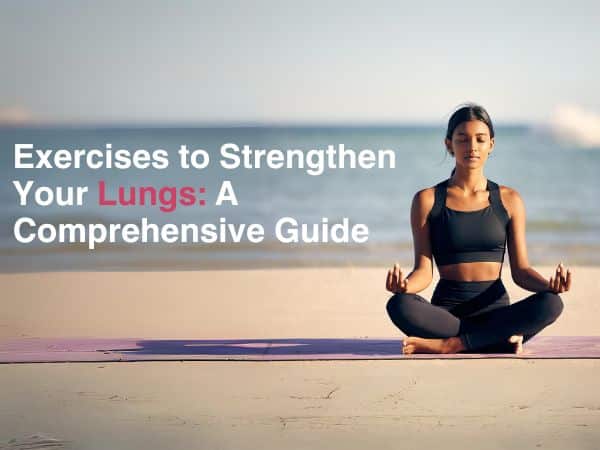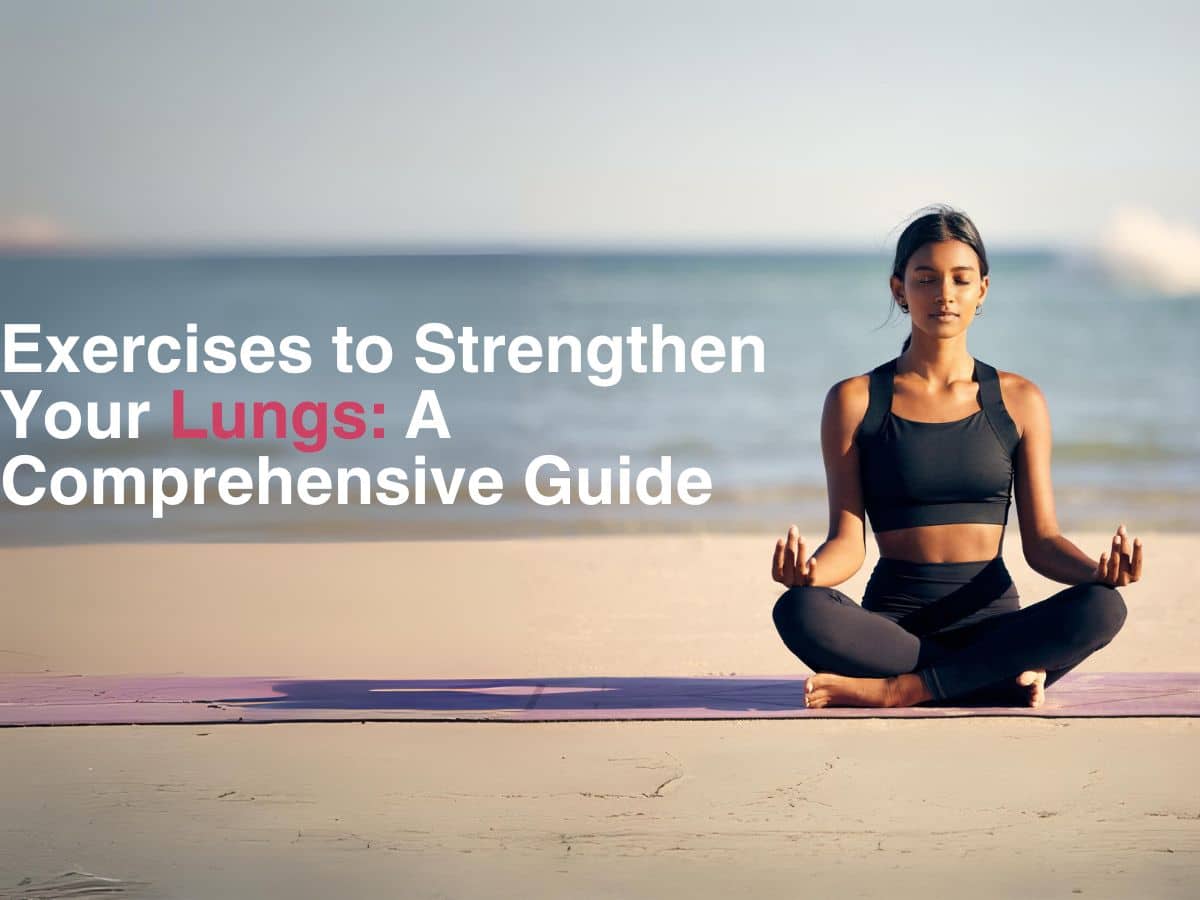
Exercises to Strengthen Your Lungs: A Comprehensive Guide

Lung health is essential for overall well-being, yet it’s often overlooked until issues arise. Whether you’re an athlete looking to enhance your performance, a senior aiming to maintain your health, or simply someone who wants to breathe better, strengthening your lungs is crucial. Regular lung-strengthening exercises can increase lung capacity, improve breathing efficiency, and boost endurance. In this guide, we’ll explore a variety of exercises to help you build stronger, healthier lungs.
Breathing Exercises to Strengthen Lungs
Diaphragmatic Breathing
Diaphragmatic breathing, also known as “belly breathing,” focuses on using the diaphragm efficiently. This technique encourages full oxygen exchange, which slows the heartbeat and stabilizes blood pressure. To practice, sit or lie down comfortably, place one hand on your chest and the other on your abdomen. Inhale deeply through your nose, ensuring your diaphragm inflates enough to create a stretch in your lungs. Exhale slowly through pursed lips.
Pursed Lip Breathing
Pursed lip breathing helps keep airways open longer, reducing the work of breathing. It’s particularly beneficial for people with lung conditions like COPD. To perform this exercise, inhale slowly through your nose. Purse your lips as though you’re about to whistle and exhale gently through them, taking twice as long to breathe out as you did to breathe in.
Box Breathing
Box breathing, also known as four-square breathing, is a simple yet powerful technique to help control your breathing. Inhale for a count of four, hold your breath for a count of four, exhale for a count of four, and then hold your breath again for a count of four. This method reduces stress and enhances lung capacity over time.
Best Exercises to Improve Lung Capacity
Aerobic Exercises (Running, Swimming, Cycling)
Aerobic exercises like running, swimming, and cycling are excellent for boosting lung capacity. These activities increase your heart rate, making your lungs work harder to supply oxygen to your body. Consistent aerobic exercise improves lung efficiency and increases the amount of oxygen your lungs can hold.
High-Intensity Interval Training (HIIT)
HIIT involves short bursts of intense exercise followed by rest or low-intensity periods. This type of training can significantly improve lung capacity and overall cardiovascular health. During HIIT, your lungs have to work harder to supply your muscles with oxygen, which over time strengthens your respiratory muscles and improves lung function.
Simple Lung Exercises for Better Breathing
Belly Breathing
Belly breathing focuses on full inhalations and exhalations, ensuring your lungs are used to their full capacity. Start by lying down with one hand on your stomach. Inhale deeply through your nose, feeling your abdomen rise, then exhale fully through your mouth.
Numbered Breathing
Numbered breathing is a rhythmic technique to enhance lung capacity. Inhale while counting to a specific number (e.g., 4), hold your breath for the same count, and then exhale while counting again. Over time, increase the count to further challenge your lungs.
Rib Stretch
Rib stretching exercises increase lung capacity by expanding the chest and encouraging deep breathing. Stand upright, exhale fully, and slowly inhale while expanding your ribcage. Hold your breath for about 10 seconds, then slowly exhale. Repeat several times.
Exercises to Boost Lung Health Naturally
Deep Breathing Exercises
Deep breathing exercises are fundamental for improving lung capacity. Practice by taking slow, deep breaths through your nose, holding the breath briefly, and then exhaling completely. This helps to oxygenate the blood and detoxify the lungs.
Chest Expansion Exercises
Chest expansion exercises involve breathing deeply while stretching your arms outward or upward, promoting full lung expansion. This exercise is particularly effective after sitting for long periods.
Controlled Coughing
Controlled coughing helps clear mucus from the lungs, making it easier to breathe. Sit in a chair with your feet flat on the floor, lean slightly forward, and cough two or three times as you exhale. This exercise is particularly beneficial for people with chronic respiratory conditions.
Effective Lung Exercises for Asthma Patients
Buteyko Breathing Technique
The Buteyko method focuses on breathing through the nose and reducing the frequency of breaths, which can help manage asthma symptoms. It emphasizes shallow breathing and holding your breath for short periods to increase tolerance to carbon dioxide.
Papworth Method
The Papworth method teaches you to use your diaphragm and breathe slowly through your nose. This technique can help reduce asthma symptoms and improve overall lung function.
Yoga Poses for Asthma
Certain yoga poses, like the Cobra and Fish pose, can open up the chest and lungs, making it easier to breathe. Incorporating these poses into your routine can help alleviate asthma symptoms and improve lung capacity.
Exercises to Increase Lung Capacity for Runners
Breathing Patterns While Running
Establishing a rhythmic breathing pattern while running can improve lung efficiency and endurance. Try to match your breathing to your steps, such as inhaling for three steps and exhaling for two.
Altitude Training
Training at higher altitudes where oxygen levels are lower forces your lungs to work harder, which can increase lung capacity and improve performance at sea level.
Respiratory Muscle Training
Using devices that create resistance while breathing can strengthen your respiratory muscles, leading to improved lung capacity and endurance.
Daily Lung Exercises for Better Breathing
Morning Breathing Routine
Start your day with a series of deep breathing exercises to wake up your lungs. This can include diaphragmatic breathing, rib stretches, and a few minutes of yoga to energize your respiratory system.
Breath Focus Techniques
Breath focus involves concentrating on your breath to reduce stress and improve lung function. Practice by sitting quietly and focusing on each inhale and exhale, gradually lengthening and deepening your breath.
Postural Exercises
Good posture is essential for optimal lung function. Practice exercises that align your spine and open your chest, such as shoulder rolls and gentle backbends, to allow for deeper breathing.
How to Strengthen Lungs with Yoga
Pranayama Techniques
Pranayama, the practice of breath control in yoga, offers a variety of techniques to strengthen your lungs. Techniques like Anulom Vilom (alternate nostril breathing) and Kapalbhati (skull-shining breath) are particularly effective for enhancing lung capacity and cleansing the respiratory system.
Yoga Poses for Lung Health
Yoga poses that open the chest, such as the Bridge pose, Camel pose, and Cow Face pose, can improve lung function and increase lung capacity. Incorporating these poses into your daily practice can lead to stronger, healthier lungs.
Meditation for Breath Awareness
Meditation that focuses on breath awareness can improve lung function and reduce stress. By sitting quietly and observing your breath, you can increase your awareness of how you breathe and make conscious adjustments to enhance lung capacity.
Lung Strengthening Exercises for Seniors
Seated Breathing Exercises
Seated breathing exercises are gentle and accessible for seniors. Practice deep diaphragmatic breathing while seated in a comfortable chair, focusing on full inhalations and slow exhalations.
Walking Exercises
Walking is an excellent low-impact exercise that can help improve lung capacity in seniors. Focus on maintaining a steady pace and breathing rhythmically to maximize the benefits.
Gentle Stretching Routines
Gentle stretching, particularly of the chest and back, can help seniors maintain good posture and lung function. Incorporate stretches that open the chest and promote full lung expansion into your daily routine.
Conclusion
Consistently practicing these lung-strengthening exercises can lead to significant improvements in lung capacity, breathing efficiency, and overall respiratory health. However, it’s important to consult with a healthcare provider before starting any new exercise routine, especially if you have pre-existing conditions. With dedication and proper technique, you can enjoy the benefits of stronger, healthier lungs for years to come.
Frequently Asked Questions
What are the best exercises to improve lung function?
- Aerobic exercises like brisk walking, jogging, swimming, or cycling
- Breathing exercises such as diaphragmatic breathing and pursed-lip breathing
- High-intensity interval training (HIIT)
- Resistance training with proper breathing techniques
How do breathing exercises help strengthen the lungs?
Breathing exercises:
- Improve lung efficiency and capacity
- Strengthen respiratory muscles
- Enhance oxygen exchange
- Help clear airways of mucus
- Reduce shortness of breath
Can regular exercise increase lung capacity?
Yes, regular exercise can increase lung capacity by:
- Improving the efficiency of oxygen uptake
- Strengthening respiratory muscles
- Enhancing the heart’s ability to pump oxygenated blood
- Increasing the number of air sacs (alveoli) in the lungs
What are some effective lung exercises for people with asthma?
- Diaphragmatic breathing
- Pursed-lip breathing
- Buteyko breathing technique
- Yoga and gentle stretching
- Swimming (in a controlled environment)
How can seniors improve their lung health through exercise?
Seniors can improve lung health through:
- Low-impact aerobic activities like walking or swimming
- Seated exercises focusing on deep breathing
- Tai Chi or gentle yoga
- Resistance band exercises with controlled breathing
- Regular stretching to maintain chest flexibility
What are the benefits of lung exercises for overall health?
Benefits include:
- Improved cardiovascular health
- Enhanced immune function
- Better stress management
- Increased energy levels
- Improved sleep quality
- Enhanced cognitive function
How does yoga contribute to stronger lungs?
Yoga contributes by:
- Promoting deep, controlled breathing
- Improving posture, which allows for better lung expansion
- Increasing chest flexibility
- Reducing stress and inflammation
- Enhancing overall body awareness and breath control
Are there specific exercises to recover lung strength after an illness?
Yes, including:
- Gradual reintroduction of light aerobic activities
- Breathing exercises like diaphragmatic and pursed-lip breathing
- Incentive spirometry (using a device to encourage deep breathing)
- Chest physiotherapy techniques
- Gentle stretching and mobility exercises
How often should lung exercises be performed for optimal results?
- Aim for at least 30 minutes of moderate aerobic exercise 5 days a week
- Practice breathing exercises for 5-10 minutes, 3-4 times daily
- Incorporate strength training 2-3 times per week
- Consistency is key; daily practice yields better results
What precautions should be taken while performing lung exercises?
- Consult a healthcare provider before starting a new exercise regimen
- Start slowly and gradually increase intensity
- Stop if you experience dizziness, chest pain, or severe shortness of breath
- Stay hydrated and exercise in a clean air environment
- Use proper form and technique, especially for breathing exercises
- For those with chronic conditions, follow guidelines provided by your doctor

Dr. K. Shirish Kumar
MBBS, MD (PULMONARY MEDICINE), FRCC&IP
Associate Consultant Pulmonology, Interventions & Sleep Medicine






